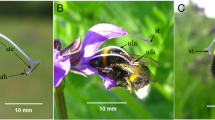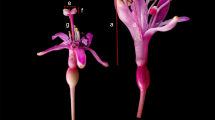Abstract
Studies of diclinous species have showed that floral sex allocation and female reproductive success were quite variable within inflorescences. However, little attention has been paid to gynomonoecious species, in which individuals produce both female and bisexual flowers. The purpose of this study was to investigate the variations in reproductive patterns at different capitulum positions within racemiform synflorescence in Ligularia virgaurea, and to determine selective mechanisms of variations in reproductive patterns. We conducted observational and experimental studies in natural populations of the gynomonoecious composite L. virgaurea. Floral sex allocation, seed production and pre-dispersal seed predation were quantified in the field. The results showed several patterns of variation from top to bottom capitula, including an increase in bisexual flowers and flower number per capitulum, but a decrease in seed set and size. Removing earlier capitula during bud stage did not change floral sex allocation in later capitula. And no effect was found on seed set under supplemental pollination. Thus, although it has been reported many times in previous studies, the variation of floral sex allocation in L. virgaurea may not result from architectural effect or mating environment, and the variation of seed production could not be fully explained by pollination success. Additionally, our results showed that L. virgaurea was susceptible to high levels of bisexual biased predation, which was greater for top capitula. We therefore suggest that these variations may help to enhance reproductive success of L. virgaurea in the face of bisexual-biased seed predation.




Similar content being viewed by others
References
Ågren JA, Danell K, Elmqvist T, Ericson L, Hjakten J (1999) Sexual dimorphism and biotic interactions. In: Geber MA, Dawson KA, Delph LF (eds) Gender and sexual dimorphism in flowering plants. Springer, Berlin, pp 217–246
Ashman TL (2002) The role of herbivores in the evolution of separate sexes from hermaphroditism. Ecology 83:1175–1184
Ashman TL (2006) The evolution of separate sexes: a focus on the ecological context. In: Harder LD, Barrett SCH (eds) Ecology and evolution of flowers. Oxford University Press, New York, pp 204–222
Ashman TL, Hitchens MS (2000) Dissecting the causes of variation in intra-inflorescence allocation in a sexually polymorphic species, Fragaria virginiana (Rosaceae). Am J Bot 87:197–204
Barrett SCH (2002) The evolution of plant sexual diversity. Nat Rev Genet 3:274–284
Bertin RI, Gwisc GM (2002) Floral sex ratios and gynomonoecy in Solidago (Asteraceae). Biol J Linn Soc 77:413–422
Bertin RI, Kerwin MA (1998) Floral sex ratios and gynomonoecy in Aster (Asteraceae). Am J Bot 85:235–244
Bertin RI, Connors DB, Kleinman HM (2010) Differential herbivory on disk and ray flowers of gynomonoecious asters and goldenrods (Asteraceae). Biol J Linn Soc 101:544–552
Bishop JG, Schemske DW (1998) Variation in flowering phenology and its consequences for lupines colonizing Mount St. Helens. Ecology 79:534–546
Brody AK (1997) Effects of pollinators, herbivores, and seed predators on flowering phenology. Ecology 78:1624–1631
Brookes RH, Jesson LK, Burd M (2010) Reproductive investment within inflorescences of Stylidium armeria varies with the strength of early resource commitment. Ann Bot 105:697–705
Brunet J (1996) Male reproductive success and variation in fruit and seed set in Aquilegia caerulea (Ranunculaceae). Ecology 77:2458–2471
Brunet J, Charlesworth D (1995) Floral sex allocation in sequentially blooming plants. Evolution 49:70–79
Brunet J, Eckert CG (1998) Effects of floral morphology and display on outcrossing in blue columbine, Aquilegia caerulea (Ranunculaceae). Funct Ecol 12:596–606
Buide ML (2004) Intra-inflorescence variation in floral traits and reproductive success of the hermaphrodite Silene acutifolia. Ann Bot 94:441–448
Buide ML (2008) Disentangling the causes of intra-inflorescence variation in floral traits and fecundity in the hermaphrodite Silene acutifolia. Am J Bot 95:490–497
Cariveau D, Irwin RE, Brody AK, Garcia-Mayeya LS, von der Ohe A (2004) Direct and indirect effects of pollinators and seed predators to selection on plant and floral traits. Oikos 104:15–26
Cornelissen T, Stiling P (2005) Sex-biased herbivory: a meta-analysis of the effects of gender on plant–herbivore interactions. Oikos 111:488–500
de Kroon H, Huber H, Stuefer JF, van Groenendael JM (2005) A modular concept of phenotypic plasticity in plants. New Phytol 166:73–82
Delph LF, Gehring JL, Frey FM, Arntz AM, Levri M (2004) Genetic constraints on floral evolution and species diversity variation among angiosperm families. Evolution 53:732–744
Diggle PK (1995) Architectural effects and the interpretation of patterns of fruit and seed development. Annu Rev Ecol Syst 26:531–552
Diggle PK (1997) Ontogenic contingency and floral morphology: the effects of architecture and resource limitation. Int J Plant Sci 158:99–107
Diggle PK, Miller JS (2004) Architectural effects mimic floral sexual dimorphism in Solanum (Solanaceae). Am J Bot 91:2030–2040
Ehrlén J (1991) Why do plants produce surplus flowers? A reserve ovary model. Am Nat 138:918–933
Fenner M, Cresswell RA, Hurley RA, Baldwin T (2002) Relationship between capitulum size and pre-dispersal seed predation by insect larvae in common Asteraceae. Oecologia 130:72–77
Guitián J (2006) Phenotypic gender variation within inflorescences of the protogynous species Helleborus foetidus L. (Ranunculaceae). Plant Syst Evol 258:137–146
Guitián J, Medrano M, Oti JE (2004) Variation in floral sex allocation in Polygonatum odoratum (Liliaceae). Ann Bot 94:433–440
Herrera CM, Medrano M, Rey AM, Sanchez-Lafuente MB, Garcia MB, Guitian J, Manzaneda AJ (2002) Interaction of pollinators and herbivores on plant fitness suggests a pathway for correlated evolution of mutualism- and antagonism-related traits. Proc Natl Acad Sci 99:16823–16828
Hiraga T, Sakai S (2007) The effects of inflorescence size and flower position on biomass and temporal sex allocation in Lobelia sessiliflora. Plant Ecol 188:205–214
Huang SQ, Tang LL, Yu Q, Guo YH (2004) Temporal floral sex allocation in protogynous Aquilegia yabeana contrasts with protandrous species: support for the mating environment hypothesis. Evolution 58:1131–1134
Itagaki T, Sakai S (2006) Relationship between floral longevity and sex allocation among flowers within inflorescences in Aquilegia buergeriana var. oxysepala (Ranunculaceae). Am J Bot 93:1320–1327
Kliber A, Eckert CG (2004) Sequential decline in allocation among flowers within inflorescences: proximate mechanisms and adaptive significance. Ecology 85:1675–1687
Kudo G, Maeda T, Narita K (2001) Variation in floral sex allocation and reproductive success within inflorescences of Corydalis ambigua (Fumariaceae): pollination efficiency or resource limitation? J Ecol 89:48–56
Lee TD (1988) Patterns of fruit and seed production. In: Lovett Doust J, Lovett Doust L (eds) Plant reproductive ecology: patterns and strategies. Oxford University Press, New York, pp 179–202
Leppick EE (1977) The evolution of capitulum types of the Compositae in the light of insect–flower interaction. In: Heywood VH, Turner BL (eds) The biology and chemistry of the Compositae. Academic, London, pp 61–89
Lloyd DG (1980) Sexual strategies in plants. I. An hypothesis of serial adjustment of maternal investment during one reproductive session. New Phytol 86:69–79
Lu Y, Huang SQ (2006) Adaptive advantages of gynomonoecious species. Acta Phytotaxon Sin 44:231–239
Luo Y, Qin G, Du G (2006) Importance of assemblage-level thinning: a field experiment in an alpine meadow on the Tibet plateau. J Veg Sci 17:417–424
Ma RJ, Du GZ, Lu BR, Chen JK, Sun K, Hara T, Li b (2006) Reproductive modes of three Ligularia weeds (Asteraceae) in grasslands in Qinghai-Tibet Plateau and their implications for grassland management. Ecol Res 21:246–254
Mani MS, Saravanan JM (1999) Pollination ecology and evolution in Compositae (Asteraceae). Science Publishers, New Hampshire
Medrano M, Guitián P, Guitián J (2000) Patterns of fruit and seed set within inflorescences of Pancratium maritimum (Amaryllidaceae): nonuniform pollination, resource limitation, or architectural effects? Am J Bot 87:493–501
Miller JS, Diggle PK (2003) Diversification of andromonoecy in Solanum section Lasiocarpa (Solanaceae): the roles of phenotypic plasticity and architecture. Am J Bot 90:707–715
Narbona E, Dirzo R (2010) Experimental defoliation affects male but not female reproductive performance of the tropical monoecious plant Croton suberosus (Euphorbiaceae). Ann Bot 106:359–369
Narbona E, Ortiz PL, Arista M (2008) Sexual dimorphism in the andromonoecious Euphorbia nicaeensis: effects of gender and inflorescence development. Ann Bot 101:717–726
Pilson D (2000) Herbivory and natural selection on flowering phenology in wild sunflowers, Helianthus annuus. Oecologia 122:72–82
Richards AJ (1997) Plant breeding systems. Chapman and Hall, London
Strauss SY, Whittall JB (2006) The evolution of separate sexes: a focus on the ecological context. In: Harder LD, Barrett SCH (eds) Ecology and evolution of flowers. Oxford University Press, New York, pp 120–138
Torices R, Anderberg AA (2009) Phylogenetic analysis of sexual systems in Inuleae (Asteraceae). Am J Bot 96(5):1011–1019
Torices R, Méndez M (2010) Fruit size decline from the margin to the center of capitula is the result of resource competition and architectural constraints. Oecologia 164:949–958
Torices R, Méndez M, Gómez JM (2011) Where do monomorphic sexual systems fit in the evolution of dioecy? Insights from the largest family of Angiosperms. New Phytol 190:238–248
Vallejo-Marin M, Rausher MD (2007) The role of male flowers in andromonoecious species: energetic costs and siring success in Solanum carolinense L. Evolution 61:404–412
Wang MT, Zhao ZG, Du GZ, He YL (2008) Effects of light on the growth and clonal: reproduction of Ligularia virgaurea. J Int Plant Biol 50:1015–1023
Wesselingh RA, Arnold LM (2003) A top-down hierarchy in fruit set on inflorescences in Iris fulva (Iridaceae). Plant Biol 5:651–660
Wise MJ, Cumming JJ (2006) Strategies of Solanum carolinense for regulating maternal investment in response to foliar and floral herbivory. J Ecol 94:629–636
Wise MJ, Hèbert JB (2010) Herbivores affect natural selection for floral-sex ratio in a field population of horsenettle, Solanum carolinense. Ecology 91:937–943
Wise MJ, Coffey LE, Abrahamson WG (2008) Nutrient stress and gall flies interact to affect floral-sex ratio in gynomonoecious Solidago altissima (Asteraceae). Am J Bot 95:1233–1239
Yampolsky C, Yampolsky H (1922) Distribution of sex forms in the phanerogamic flora. Bibliogr Gene 3:1–62
Zhao ZG, Meng JL, Fan BL, Du GZ (2008) Reproductive patterns within racemes in protandrous Aconitum gymnandrum (Ranunculaceae): potential mechanism and among-family variation. Plant Syst Evol 273:247–256
Acknowledgments
We thank Wei Li, Peng Jia, Zhi-long Zhang and Chun-hui Zhang for helps in the field and lab work; Zhi-gang Zhao, Ren-yi Zhang, and Man-tang Wang for helpful comments of several aspects of this work; Marcos Méndez and Rubén Torices made useful comments to improve the manuscript. This project was funded by a State Key Project for Natural Science Foundation (No. 30770359).
Author information
Authors and Affiliations
Corresponding author
Rights and permissions
About this article
Cite this article
Zhang, G., Xie, T. & Du, G. Variation in floral sex allocation, female success, and seed predation within racemiform synflorescence in the gynomonoecious Ligularia virgaurea (Asteraceae). J Plant Res 125, 527–538 (2012). https://doi.org/10.1007/s10265-011-0466-2
Received:
Accepted:
Published:
Issue Date:
DOI: https://doi.org/10.1007/s10265-011-0466-2




